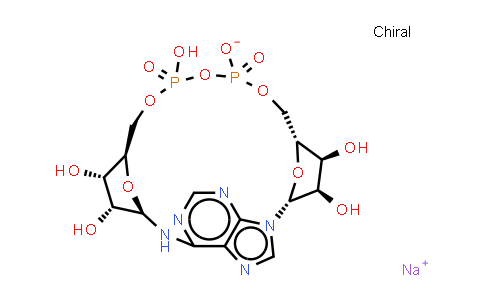| Chemical Name |
Cyclic ADP-ribose |
| CAS Number |
119340-53-3 |
| MDL Number |
MFCD04113746 |
| Molecular Formula |
C15H20N5NaO13P2 |
| Molecular Weight |
563.28 |
| Synonyms |
cADPR |
Introduction of 119340-53-3 :
Cyclic ADP-ribose (cADPR) is a potent second messenger for calcium mobilization that is synthesized from NAD+ by a ADP-ribosyl cyclase. Cyclic ADP-ribose increases cytosolic calcium mainly by Ryanodine receptor-mediated release from endoplasmic reticulum and also by extracellular influx through the opening of TRPM2 channels[1]. IC50 & Target: Calcium mobilization[1]
TRPM2 channels[1]
Endogenous metabolite[1] In Vitro: In cells, Cyclic ADP-ribose (cADPR) is an important player in processes such as: cell proliferation and differentiation, regulating e.g. expansion of human mesenchymal stem cells and hemopoietic progenitors, neuronal differentiation of PC12 cells, and cardiomyocyte differentiation of mouse embryonic stem cells[1]. In Vivo: In mammals, Cyclic ADP-ribose (cADPR) is an important player in processes such as: inflammatory and immune responses, including neutrophil chemotaxis and T cell activation; smooth muscle cell contraction in arteries and bronchi, with participation in the hypoxic pulmonary vasoconstriction and in the pathogenesis of inflammatory/allergic airway diseases; myometrium contractility, eventually contributing to delivery; myocyte contraction in adult cardiac tissue, participating in angiotensin II- and β-adrenergic-induced cardiac hypertrophy and in isoproterenol-induced arrhythmias; endocrine and exocrine pancreatic secretion; and social behaviour in mice, including memory formation and spatial learning, related to oxytocin secretion and maybe to niacin deficiency[1].
Furthermore, Cyclic ADP-ribose (cADPR) is involved in egg activation and fertilization in ascidians and sea urchin, in early development in sea urchin, in abscisic acid signalling in sponges and plants, in cell fission in dinoflagellates, and in Toxoplasma gondii pathogenicity[1].
| Purity |
NLT 98% |
| Storage |
at 20ºC 2 years |
*The above information is for reference only.
